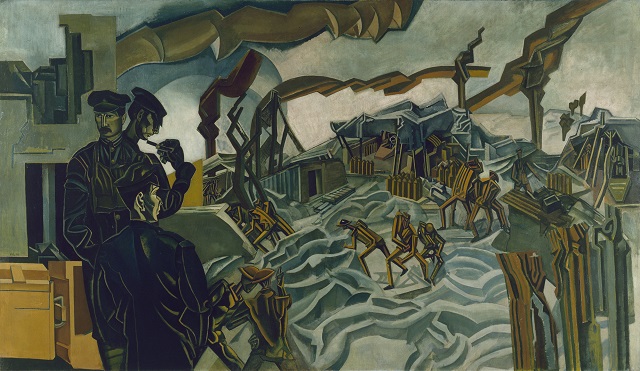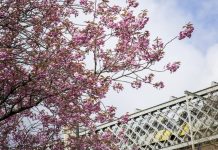It’s the biggest exhibition of Wydham Lewis’ work since 1956 and it’s come to Manchester-we went to take a look
One story about Wydham Lewis is that he hated being recognised on the streets all through his life he would change almost chameleon like yet he would court publicity in his arguments with the intellectual elite.
One painting on show here is his portrait of the writer TS Elliott from the 1930’s rejected by the National Gallery as being neither photographic or impressionistic, it was shipped off to South Africa instead but Lewis created a storm in the press over the incident, Churchill joined the controversy defending the gallery, and the now 56 year old artist celebrated that he was once again the young rebel in the world of art.
Lewis is best known as a war artist but this exhibition seeks to portray him as so much more and to a great extent succeeds.
Lewis was an artist for some, others know him better as a writer and satirist, what is so extraordinary is that there is no comparable artist, possibly with the exception of William Blake,like Blake, Lewis was a creator of many things.
This chronologically displayed exhibition will take you from the earliest works of the artist to his final days blinded by the disease that would kill him.
The first work you will see as you enter the gallery is his An Oriental design, one of his earliest works which has only just appeared again in public after being in the art critic Brian Sewell’s private collection.
Painted around 1899 at Slade school of art which Lewis had joined only a year earlier at the age of 15 and from which he would be expelled from for poor attendance, it is said Augustus John turned up at a life drawing class, the sketch becameLewis aping John, aping Rembrandt when Lewis was actually being taught to draw in the Renaissance style of Michelangelo.
Few of Lewis’s early works survive but those that did are here, including The Nudes painted in 1903 in ink and ink wash, expressive, it is said of Lewis’s fascination of the works and world of Nietzsche.
A radical force in British art and literature, Wyndham Lewis was the founder of Britain’s only true avant-garde movement, Vorticism. He was a controversial figure whose ideas, opinions and personality inspired, enticed and repelled in equal measure.
From a mythologized birth in Canada, Lewis spent his youth in England and traveled Europe.
He would live the bohemian life in Paris before the First World War.
Here from that period is Man and Women painted in 1912 and almost certainly reminiscent of aGaugin, it was one of many paintings done while Lewis was in Brittany, and encountered the post impressionists
In 1913, he joined Roger Fry’s Omega Workshops before setting up his own rival group, just four months later aptly named The Rebel Art Centre.
Here the smiling women ascending a stair is on display, her mask glaring at the viewer.
Lewis was unusual, seeing the narrative potential of cubanism and avante garde, you can see this in the exhibition in his Timon of Athens piece.
Most people fell out with the Bloomsbury set at their peril, for Lewis it was a challenge he, although in later life his said his one mistake in life was to quarrel with Roger Fry.
Lewis would become almost the inventor of geometric non rep art, one of his disciples Lawrence Atkinson based as it happens in Manchester’s work Abstract, painted in 1915 is on display here.
From there arose Vorticism, its arresting manifesto BLAST encapsulating the restless mood pervading Britain on the eve of the First World War.
It is his war work that Lewis has been most remembered for and a large amount is on display here.
Serving as commissioned artillery officer during the conflict, Lewis was appointed an official war artist first for the Canadians and then the British.
He never expected to return from the conflict, joined the artillery, caught trench fever and would produce two works while recovering in Etaples, two missionaries, a satirical take on Missionaires confronting natives in the South Pacific and the Gossips.
His experiences as an observation officer would give him a unique vantage point and in 1917 he was commissioned by the Canadians to be their war artist, the British would take him on the following year, the paintings that followed shell humping,action, officers and signallers show the almost futileness of war whilst his battery position in a wood shows a side of war never portrayed, the domesticity of the trenches while his figures show an almost robotic appearance.
And then his massive canvas piece, a battery shellled, a dichotomy a seperation of what you experience and what you see, the figures on the left are real, while on the main picture the troops are robotic,
It was put on show in 1919, as part of an exhibition of war art at the Royal Academy, it was slated by the tabloids, it prompted questions in Parliament, yet its defenders would see it as a horrible picture depicting a horrible war.
The critics won though and it was soon packed off to the Tate Gallery.
After the war, he carries on modernism in a shell shocked society, his reading of Ovid, showing that he felt society had trangressed into an almost infantile post war haze, the grinning Tyro prevelent in many of his works was his response.
He spent a lot of time perfecting his draftsmanship during this time as well, these are also on display, some very expressive but not through the face but through the body, his poet seated Ezra Pound on show here is a good example.
There is also a drawing entitled the Cabbie, where the face springs out while the rest of the body fades into the canvas.
There are pictures of his friends, Edith Sitwell painted after his satatorical writings on the world of literature, in the Apes of God, finishing the portrait in 1935 in her absence after they had fallen out.
Falling out is something that Lewis would do well and often, he would, during his career attack many of his friends, but they would brush it off at “well it’s only Wyndham.”
In 1930 he wrote to the Leicester Gallery complaining that art had lost its way and proposing that he rectify it , the paintings that came out of that exhibition which only came to fruition in 1937, are all here, a series all said to be related.
Two beach babies, a satirical piece which includes a strange red Indian figure,the convalescent, inca with birds, all very mysterious and still being interpreted today-they fill the final third of the exhibition with terrific colour.
Inferno was the climax, still wet when it was exhibited in 1937, a macabre ending to the series described by the painter as a world of shapes locked in eternal conflict.
War was approaching, Lewis had stopped almost stoppped painting, instead devoting to writing, producing the magazines the Tyro, and the Enemy Time and Western Mam
He was also write pro appeasement books but after visiting Germany in 1937, he was appalled, and wrote the Jews, a book arguing for Jews to be accepted into the Uk as part of a mass immigration policy.
When war broke out he decided that he didn’t want to watch Europe destroy itself and witness the end of European culture and went to America
The black art which came out of that period, also on show here, would come out of his philosophy of the absurd.
After the war he would write America and the Cosmic man which would hold up the American model of democracy as the template for the future of mankind
The last picture -a Canadian war factory was his last commission, unusually for the time paid upfront, he struggled to finish it, he was having problems with his eyesight, an undiagnosed brain turmour, which would eventually lead to his death, had crushed an optic nerve leading to blindness and would only appear after his death while the haunting portrait by his friend Michael Aryton shows Lewis in his final days wearing a visor to protect his eyes.
This is an exhibition not to be missed, made all the most poignant by the fact that it takes place in iconic building designed by world-renowned architect Daniel Libeskind.
Lewis’ art has a complementary relationship with IWM North’s dynamic design. The striking shards of the building bear direct resemblance to Lewis’ Vorticist style of painting, with linear and hard edge shapes derived from the machine and the urban environment.
Wyndham Lewis: Life, Art, War
IWM North
23 June 2017 – 1 January 2018
Tickets now on sale at iwm.org.uk/north
Adult £8, Child £4, Concessions £6, Members







